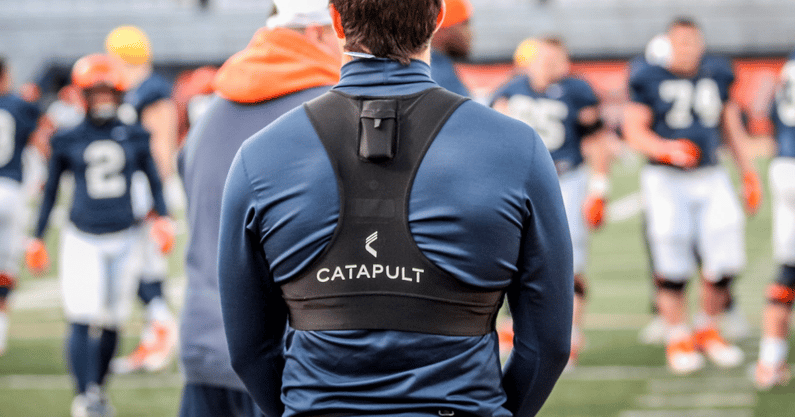CFP teams count on performance-related data from wearable devices

The four teams participating in this season’s College Football Playoff have one thing in common: They all rely on the same sports performance analytics company, Catapult, for performance data and video analysis technology.
Catapult, which works with more than 3,400 teams worldwide, has cornered the market on CFP teams — and it doesn’t stop there. At least 90 percent of FBS teams are clients of Catapult. And this football season, the company counts nine of the 10 conference champions as clients, as well as every SEC team.
“We really feel like we are partners with them,” Matt Bairos, Catapult’s chief commercial officer, told On3. “And many of the athletes that were using our system [in the past] are now coaches, so it’s a whole community with American football.”
In the lead-up to the CFP semifinals on New Year’s Eve, Alabama, Cincinnati, Georgia and Michigan will lean on Catapult technologies, which largely fall into two buckets: video analysis and a treasure trove of performance-related data from wearable devices.
Teams first started to adopt the company’s video platform some 20 years ago. A decade later, some early adopters — including Jimbo Fisher at Florida State — emerged to begin using Catapult’s wearable devices for athletes. Initially, these were tools for just the premier programs searching for any competitive edge they could find. But now it has penetrated deep into the Group of 5 ranks, with plans to expand to elite high school programs as well.
The goals are two-fold: optimizing performance and minimizing the risk of injury. Catapult’s wearable devices are calibrated to be worn precisely between the athlete’s shoulder blades, as close to the body as possible. One of its primary metrics quantifies an athlete’s load, which measures exertion during a game or practice. But there are other, more nuanced metrics, such as assessing inertia. For instance, when linemen collide, data can quantify the impact’s power, assessing the physical load the athlete is accumulating.
Bairos said one SEC team performed a study with its offensive linemen, comparing game-day performance with what was occurring during the week in practice. While much of the focus of coaches and trainers these days centers on trying to avoid over-training, which could increase the likelihood of injury, this SEC team found that linemen were actually under-training during the week. So there was room to ramp up practice intensity without increasing the risk of injury.
Whether you’re a Division I performer or recreational athlete, the demand for performance-related data measured by wearable devices has exploded in the past few years. An avalanche of personalized data related to heart rate, heart rate variability, respiratory rate, positional tracking, sleep and recovery has been thrust into the mainstream in a fast-evolving industry where annual user spending approaches $50 billion. And there is no end-point in sight: The next frontier could entail accurate hydration status monitoring and user-friendly 3D modeling to analyze athletes’ motion.
Top 10
- 1New
YouTube TV, ESPN dispute
Google blasts ABC
- 2
College Football Playoff
Teams that remain in the hunt
- 3Hot
BCS Formula
Predicts first CFP Top 25
- 4
CFP Top 25 predictions
Projecting first rankings
- 5Trending
Auburn Hot Board
Top candidates to replace Freeze
Get the Daily On3 Newsletter in your inbox every morning
By clicking "Subscribe to Newsletter", I agree to On3's Privacy Notice, Terms, and use of my personal information described therein.
“It continues to evolve, right?” Bairos said. “It’s not just watching film. The video is the backdrop, but it’s really about how you’re combining data and becoming more predictive and prescriptive in terms of what we can put in front of the coaches to help them save time and make them better, faster and smarter when they are preparing for the game.”
Catapult is continuing to work on more sport-specific and position-specific solutions for its teams, recognizing that the demands of positions can vary greatly. What’s more, the company recently launched Catapult One, which measures core metrics that improve performance. It will exhibit at the upcoming American Football Coaches Association convention in San Antonio.
Bairos said Catapult is proud to see four clients reach the CFP semifinals. And loftier goals loom if and when the CFP expands. “Twelve for 12 would be great,” Bairos said.
Quick hits
+ Duke’s Mayo Bowl, which matches North Carolina against South Carolina on Dec. 30, will be among the bowls stepping foot into the NIL space. An “ambassador” from the winning team will be named and offered a $5,000 contract to promote the game during the offseason. The bowl game is working with Opendorse on the deal.
+ Altius Sports Partners, which offers NIL advisory services to schools, has secured multiyear contract extensions with the athletic departments of Tennessee, Georgia and USC. The announcement follows the company landing long-term agreements this fall with Texas, LSU and South Carolina. Altius specializes in providing partners with guidance, consultation and education support during the NIL era.